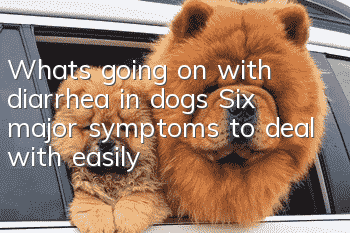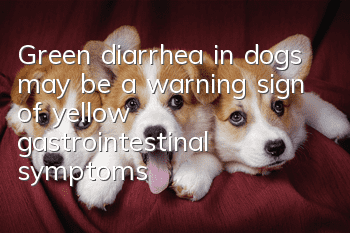What’s going on with diarrhea in dogs? Six major symptoms to deal with easily

Dog diarrhea may be a cold
Symptoms: Loose or soft stools, vomiting, lack of energy, watery nose, loss of appetite, etc.Coping methods: Feed the dog Pet Cold Spirit, pay attention to keeping warm from the cold, feed plenty of warm water, add warm cushions and thin blankets to the kennel in a timely manner, and do not place the kennel in the In windward areas, where the temperature difference between day and night is large, dogs are prone to colds and colds; do not bathe your dogs during a cold period, and be sure to dry them with hot air in a timely manner after bathing after the cold is over.
Dog diarrhea may be a parasitic infection
Symptoms: Diarrhea, blood in the excrement, or white worms. Some dogs will be accompanied by vomiting symptoms. He is mentally normal and has no other complications.Coping methods: Feed internal anthelmintics and perform internal deworming treatment regularly; do not feed raw water, raw meat, or human food, and keep a leash when going out for walks to prevent dogs Dogs become infected with parasites by sniffing and licking everywhere.
The dog's diarrhea may be caused by a sudden change of dog food
Symptoms: Diarrhea or loose stools, but normal appetite, normal spirit, and no other complications.Coping method: Change the dog food back to what it ate before, and then feed probiotics to regulate the gastrointestinal tract; then feed it with a ratio of new and old dog food of 1:5, and adjust it to 2: after a week. 4. Such a gradual and gradual transition. The entire transition period for food replacement should be about one month. Don't change it all at once. It takes a certain amount of time for the digestive enzymes in the dog's gastrointestinal tract to adapt to the new dog food. If parents fail to make the transition well, it will easily lead to an imbalance of gastrointestinal flora, cause diarrhea, and affect normal digestion and nutrient absorption. It is best not to change brands frequently, but to change flavors.
Dogs may have diarrhea due to overeating or accidental ingestion
Symptoms: The frequency of diarrhea may not be frequent, and may be accompanied by vomiting of undigested food. They are in normal spirits and have no other symptoms. Any discomfort.Coping methods: Fast for about 12-24 hours, feed regularly and quantitatively, and control the eating time within 30 minutes, and remove the food bowl when the time is up. Condition the gastrointestinal tract with probiotics. Do not feed bones or leftovers to your dog to avoid irritating the gastrointestinal tract.
Dog diarrhea may be gastroenteritis
Symptoms: Watery diarrhea or watery stools, loss of appetite, severe bloody excrement, and vomiting after eating. ,Coping methods:Send to the doctor for examination in time, and at the same time switch to liquid food that is nutritious and easy to absorb., such as chicken porridge, or use goat milk to soak dog food until soft, and cooperate with drug treatment.
Dog diarrhea may be canine distemper parvovirus
Symptoms: Diarrhea with blood and severe sour odor, vomiting of yellow water, lack of energy, and elevated body temperature ( 38-39°C for puppies, 37.5-38.5°C for adult dogs is normal), lethargy, loss of appetite and many other complications.Coping methods: Send to the doctor immediately for treatment. If there are canine distemper and parvovirus test strips at home, you can test them at home first.
Random articles
- What is the behavior of dogs and wolves howling?
- Are mites on dogs contagious to humans?
- What will happen if the dog bites for more than 24 hours?
- Dogs have symptoms of parasites
- What will happen if your dog eats too many trace elements?
- Why is the dog's mouth swollen?
- How long does it take for a dog to adapt to a new home?
- Husky’s love for its owner
- Symptoms of dog stuck in throat
- How to cook carrots for dogs



